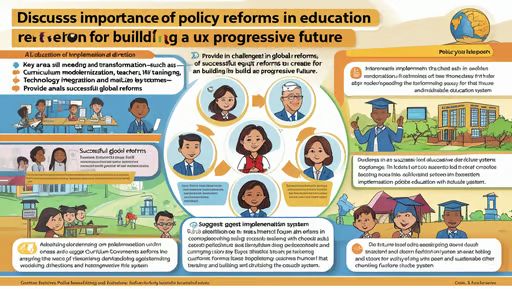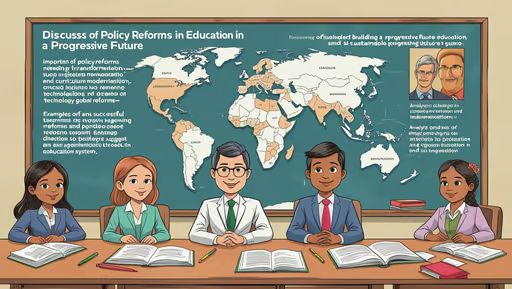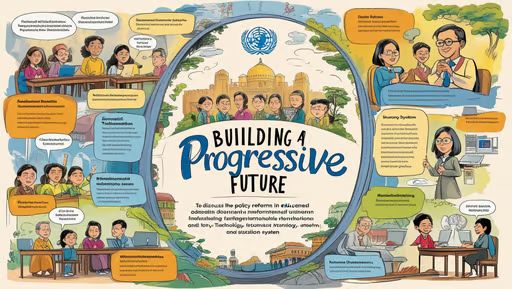Introduction
Policy Reforms in Education for a Progressive Future, Education is the cornerstone of societal development, economic growth, and individual empowerment. Over the years, education systems worldwide have undergone numerous reforms to adapt to changing societal needs, technological advancements, and global challenges. Policy reforms in education aim to enhance accessibility, improve quality, promote equity, and ensure that learning outcomes align with the demands of the 21st century.
This article explores the significance of policy reforms in education, key areas requiring transformation, successful global examples, challenges in implementation, and future directions for creating an inclusive and effective education system.
The Need for Policy Reforms in Education
The traditional education system, largely designed during the industrial era, often fails to meet contemporary needs. Rapid technological advancements, globalization, and evolving job markets necessitate a shift in how education is delivered and assessed. Some pressing reasons for policy reforms include:
- Skill Gap and Employability – Many education systems focus on rote learning rather than critical thinking, creativity, and problem-solving, leaving graduates unprepared for modern workplaces.
- Digital Transformation – The rise of AI, automation, and digital tools requires integrating technology into education.
- Equity and Inclusion – Disparities in access to quality education persist based on socio-economic status, gender, and geographic location.
- Global Competitiveness – Nations must align their education policies with global standards to remain competitive.
- Sustainable Development Goals (SDGs) – SDG 4 emphasizes inclusive and equitable quality education for all by 2030, necessitating systemic reforms.
Key Areas for Policy Reforms
1. Curriculum Modernization
A rigid, outdated curriculum limits students’ ability to thrive in a dynamic world. Reforms should focus on:
- STEM and Digital Literacy – Integrating coding, AI, and data science from an early age.
- Soft Skills Development – Encouraging collaboration, communication, and emotional intelligence.
- Interdisciplinary Learning – Breaking silos between subjects to foster holistic understanding.
- Sustainability Education – Incorporating climate change, environmental ethics, and sustainable practices.
2. Teacher Training and Professional Development
Teachers are the backbone of education, yet many lack adequate training. Reforms should include:
- Continuous Professional Development (CPD) – Regular upskilling in pedagogy and technology.
- Competitive Salaries and Incentives – Retaining talented educators by improving working conditions.
- Mentorship Programs – Pairing novice teachers with experienced mentors.
3. Technology Integration
The COVID-19 pandemic highlighted the importance of digital learning. Key reforms include:
- Digital Infrastructure – Ensuring schools have internet access, devices, and e-learning platforms.
- Blended Learning Models – Combining online and offline education for flexibility.
- AI and Personalized Learning – Using adaptive learning technologies to cater to individual student needs.

4. Equity and Inclusion
Millions of children remain out of school due to poverty, disability, or discrimination. Reforms must address:
- Free and Compulsory Education – Expanding policies like India’s Right to Education (RTE) Act.
- Gender Equality – Encouraging girls’ education through scholarships and safe school environments.
- Special Needs Education – Providing inclusive classrooms and assistive technologies.
- Rural Education – Building schools, training local teachers, and offering remote learning options.
5. Assessment and Examination Reforms
Traditional exams often measure memorization rather than understanding. Progressive reforms include:
- Continuous and Comprehensive Evaluation (CCE) – Assessing skills beyond written tests.
- Project-Based Assessments – Encouraging practical application of knowledge.
- Reducing Exam Stress – Shifting from high-stakes testing to competency-based evaluations.
6. Public-Private Partnerships (PPPs)
Governments alone cannot fund all educational needs. Collaborations with private entities can:
- Improve Infrastructure – Building schools and digital labs.
- Enhance Vocational Training – Partnering with industries for skill-based programs.
- Boost Research and Innovation – Funding universities and startups.

Global Examples of Successful Education Reforms
1. Finland’s Holistic Education Model
- No Standardized Testing – Focuses on teacher autonomy and student well-being.
- Play-Based Learning – Early education emphasizes creativity over academics.
- Highly Qualified Teachers – Only top graduates can enter teaching programs.
2. Singapore’s SkillsFuture Initiative
- Lifelong Learning – Offers subsidies for adult education and upskilling.
- Industry-Aligned Curriculum – Partners with employers to design relevant courses.
3. Estonia’s Digital Education Revolution
- Coding from Grade 1 – Integrates programming into primary education.
- E-Governance in Schools – Digital platforms streamline administration and learning.
4. Kenya’s Competency-Based Curriculum (CBC)
- Focus on Skills Over Exams – Reduces rote learning and enhances creativity.
- Parental Involvement – Encourages community participation in education.
Challenges in Implementing Education Reforms
Despite good intentions, reforms face obstacles such as:
- Political Resistance – Changes often face opposition from policymakers favoring traditional systems.
- Funding Constraints – Limited budgets delay infrastructure and teacher training.
- Bureaucratic Delays – Slow implementation hampers progress.
- Cultural Barriers – Societal resistance to new teaching methods.
- Teacher Resistance – Educators may resist changes due to lack of training or fear of job insecurity.
Future Directions for Education Policy Reforms
To build resilient education systems, future reforms should focus on:
- AI and Adaptive Learning – Customizing education based on student performance.
- Global Collaboration – Sharing best practices across nations.
- Mental Health Integration – Addressing student stress and well-being.
- Lifelong Learning Ecosystems – Supporting continuous education for all ages.
- Climate-Conscious Education – Preparing students for green jobs and sustainability challenges.
Conclusion
Education policy reforms are crucial for nurturing future-ready generations. By modernizing curricula, empowering teachers, leveraging technology, and ensuring equity, nations can build inclusive and effective education systems. While challenges exist, global examples prove that transformative reforms are possible with political will, investment, and community engagement. The future of education lies in adaptability, innovation, and a commitment to lifelong learning for all.

0k9res